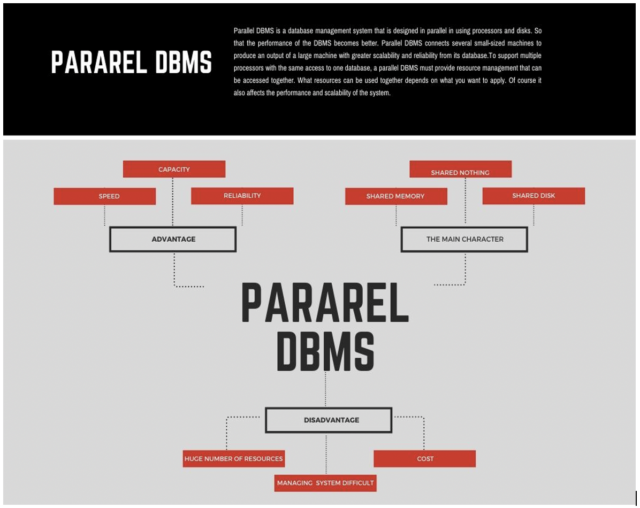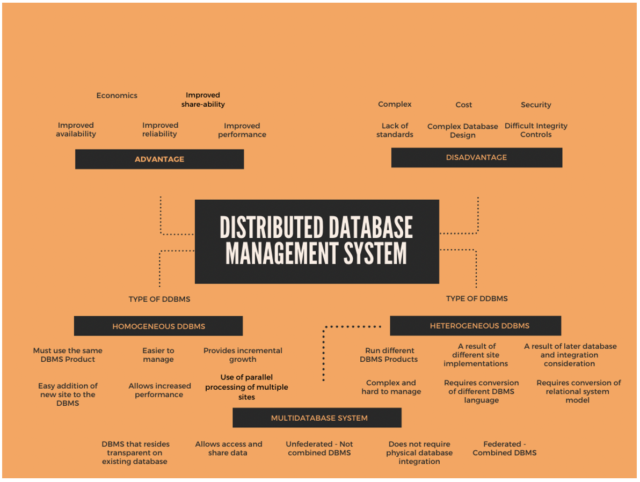Parallel DBMS and Distributed DBMS
Parallel DBMS is a Database Management System that runs through multiple processors and disks. They combine two or more processors also disk storage that helps make operations and executions easier and faster. They are designed to execute concurrent operations. They exist, happen, or done at the same time even if the data processed are not from one source or one processing unit.
The main architecture for parallel DBMS is:
- Shared Memory System
A Shared Memory System is an architecture of Database Management System, where every computer processor is able to access and process data from multiple memory modules or unit through intercommunication channel. This architecture is also commonly known as SMP or Symmetric Multi-processing. A Shared Memory System contains large amounts of cache memories at each processor, so referencing of the shared memory is avoided.Advantages of Shared Memory:· Data is easily accessed from various processors.· A single processor can send messages to other processors efficiently. Disadvantage of Shared Memory:· Waiting time for every single processor increases when all of them are uses.· Bandwidth is also a problem.2. Shared Disk System
A Shared Disk System is an architecture of Database Management System where every computer processors can access multiple disk through intercommunication network. It can also access and utilize every local memory. Each of the processors have own memory system, so the shared data are more efficient.
Advantages of Shared Disk System:
- The fault tolerance can be achieved using this system.
Disadvantages of Shared Disk System:
- The addition of processors can slow down existing processors.
- Shared Disk System have a limited scalability meaning it is sometimes fixed.
- Shared Nothing System
A Shared Nothing System is an architecture of Database Management System where every processor has their own disk and memory for the objective of efficient workflows. The processors can communicate with other processors using intercommunication network. Each of the processors act like servers to store data on the disk. So there can be an efficient and effective workflows.
Advantage of Shared Nothing System
- This system has more scalability.
- Number of processors and disk can be connected as per the requirement in share nothing disk system.
Disadvantage of Shared Nothing system
- Must require the partitioning of data.
- Cost that need for this system is higher.
- Advantages of parallel DBMS :
- Speed
The first advantage of parallel DBMS is speed. The servers from parallel DBMS are able to break up user database request into parts and it dispatches each of the parts to separate computers. They work on these “work parts” simultaneously and they merge the results, passing them back to the user. This speeds up most of the data requests, allowing faster access to very large databases.
- Reliability
The second advantage is reliability. A parallel database when properly configured, can continue to work despite the failure of any computer in the cluster. The database server can sense that a specific computer is not responding, and it can reroute its work to the remaining computers.
- Capacity
The third advantage is capacity. As more and more users request access to the database, the computer administrators add more computers to the parallel server, boosting its overall capacity to the max, databases are more likely to slow down and have slower system. A parallel database, for example, allows a large online retailer to have thousands of requests of users accessing information at the same time. This level of processing performance is not possible with single server systems.
- Disadvantage of Parallel DBMS :
- Cost
The first disadvantage of parallel DBMS is cost. As the need of quicker processing and efficient searches increase, there need to be more and more disks and processors that simultaneously work together to achieve the best and quickest results. To do that, Parallel DBMS needs lots of processors and disks in the first place. At the end, it is never cheap to implement parallel DBMSs.
- Resources
The second disadvantage of parallel DBMS is the huge amount of resources. It is not and will never be easy to keep up with modern, cheap, and efficient resources. Implementing DBMS requires the users or the company to have renewal of resources, changing or maintaining resources, or even replacement of resources.
- Difficulty of Managing Systems
The third disadvantage of parallel DBMS is the difficulty in systems managing. When having lots of systems, lots of resources, and lots of systems running it is never easy to manage them. When there needs to be a software update, a replacement, or maintenance that all of the system needs to do, it will be time consuming and resource consuming.
MindMap Parallel DBMS
MindMap DDBMS
Source :
- https://www.techwalla.com/articles/the-purpose-of-computer-networking
- https://bundet.com/pub/detail/pengertian-paralel-dbms-1547270868
- https://www.answers.com/Q/What_are_the_Disadvantages_of_parallel_database_architecture
- http://www.exploredatabase.com/2014/02/parallel-database-architectures.html



